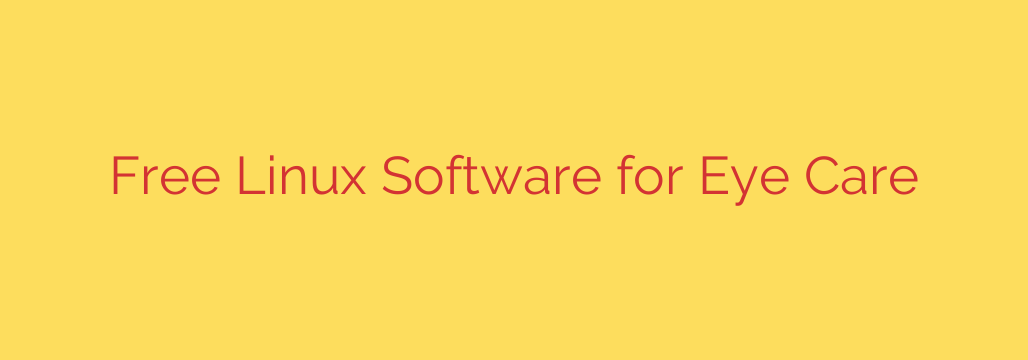
Reduce Eye Strain on Linux: Top Free Tools to Protect Your Vision
If you’re a Linux user who spends hours in front of a screen, you’re likely familiar with the symptoms of digital eye strain: dry eyes, headaches, blurred vision, and fatigue. These issues are often exacerbated by the harsh blue light emitted by modern displays, which can disrupt sleep patterns and cause discomfort. Fortunately, the open-source community provides powerful, free tools designed to mitigate these problems and make your screen time significantly more comfortable.
Protecting your vision isn’t a luxury; it’s an essential part of sustainable productivity and long-term health. By integrating specialized software into your workflow, you can reduce eye fatigue, improve focus, and even enhance your sleep quality. Here’s a look at the best free eye care applications available for your Linux system.
Why You Need Eye Care Software on Linux
Most modern operating systems now include some form of “night mode,” but the tools available on Linux often offer far greater control and customization. These applications work in two primary ways:
- Filtering Blue Light: They automatically adjust the color temperature of your screen, reducing the amount of sleep-disrupting blue light, especially in the evening. This warms the screen’s color palette, making it easier on the eyes and helping to preserve your natural circadian rhythm.
- Enforcing Breaks: Some tools are designed to remind you to step away from the screen at regular intervals. This encourages habits like the 20-20-20 rule (every 20 minutes, look at something 20 feet away for 20 seconds), which helps prevent your eye muscles from locking into a fixed focus.
The Best Free Eye Care Software for Linux
Redshift: The Command-Line Classic
For many Linux users, Redshift is the go-to solution for color temperature adjustment. It’s a lightweight, reliable, and highly configurable tool that gradually shifts your screen’s color temperature based on the time of day. During the day, it maintains a neutral color, but as the sun sets, it slowly introduces a warmer, reddish tint to minimize blue light exposure.
- Key Feature: Automatically detects your location to sync with local sunrise and sunset times.
- Best For: Users who want a “set it and forget it” solution that runs efficiently in the background. Many desktop environments even include a GUI front-end for Redshift for easier control.
Gammy: The Adaptive Brightness Solution
Gammy takes a unique approach by adjusting screen brightness and color temperature based on what’s on your screen, not just the time of day. For example, if you switch from a dark-themed code editor to a bright white web page, Gammy can automatically dim the screen to prevent a sudden, harsh glare. This real-time adaptation provides a level of comfort that time-based tools can’t match.
- Key Feature: Screen content-aware brightness and temperature adjustment.
- Best For: Users who frequently switch between light and dark applications and want to avoid the jarring shock of sudden brightness changes.
SafeEyes: The Intelligent Break Reminder
While filtering blue light is crucial, so is resting your eyes. SafeEyes is a simple yet powerful utility designed to enforce healthy break habits. It reminds you to take short breaks at regular intervals, often locking your screen to ensure you actually step away. The reminders are fully customizable and non-intrusive, helping you build a healthier work routine without being annoying.
- Key Feature: Provides short break reminders with optional simple exercises, along with longer breaks to encourage you to get up and move around.
- Best For: Anyone who gets lost in their work and forgets to take regular breaks to rest their eyes and body.
Brightness Controller: For Ultimate Screen Control
Sometimes, your system’s default brightness settings just aren’t enough, especially when working in a very dark room or using multiple monitors. Brightness Controller is a straightforward utility that gives you granular control over screen brightness, allowing you to dim your display far below the default minimum level. It can also manage the brightness of multiple external monitors from a single, simple interface.
- Key Feature: Controls primary and secondary monitor brightness and can reduce levels below the hardware’s default minimum.
- Best For: Users with multi-monitor setups or those who need to work in very low-light environments.
Beyond Software: Practical Habits for Healthier Eyes
While these tools are incredibly effective, they work best when combined with good habits. Here are a few actionable tips to further protect your vision:
- Practice the 20-20-20 Rule: Make a conscious effort to look away from your screen every 20 minutes at an object at least 20 feet away for 20 seconds.
- Optimize Your Workspace: Position your monitor so the top of the screen is at or slightly below eye level. Ensure you have adequate ambient lighting to reduce glare and contrast.
- Blink Frequently: When we stare at screens, we tend to blink less often, which can lead to dry, irritated eyes. Make a conscious effort to blink more.
- Stay Hydrated: Dehydration can contribute to dry eyes, so be sure to drink plenty of water throughout the day.
By combining these powerful Linux tools with mindful habits, you can take meaningful steps to protect your eyes, improve your focus, and ensure your long hours at the computer are both productive and healthy.
Source: https://www.linuxlinks.com/eye-care-best-free-linux-software-eyes/








